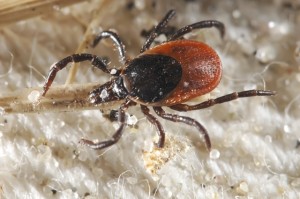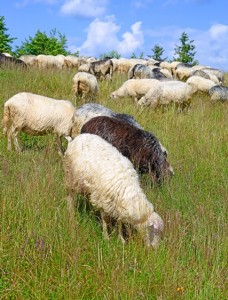Sheep Diseases
Louping-ill
Clinical Signs for Louping-ill
Following infection, between 5 and 60 per cent of animals develop clinical signs, which vary from slight ataxia to sudden death. There is usually biphasic fever with encephalomyelitis following the second rise. The animal is dull, the head is held low and it may head press. Muscle tremors and muscle rigidity are apparent, particularly on the head and neck. There is a louping gait with both front legs being moved forward together, followed by the back ones. Often there is hyperaesthesia to sound or touch. Jaw champing occurs and in some cases drooling of saliva and protrusion of the tongue. During the latter stages of the disease, lateral recumbency occurs with a normal corneal reflex. Some animals paddle whilst others become paralyzed. Death usually follows (Reid, 1991, 1990). It has been shown that tick-borne fever increases the susceptibility of sheep to louping-ill virus and invariably causes death from a hemorrhagic syndrome involving a systemic mycotic infection with Rhizomucor pusillus (Brodie et al., 1986; Reid et al., 1986).
The Disease Vector

The vector for transmitting louping-ill virus is the common sheep tick, Ixodes ricinus, also known as the castor bean tick. Their lifecycle takes 3 years, as the ticks only feed for a few days each year, as larva in the first year, a nymph in the second and an adult in the third (Taylor et al 2007).
Ixodes ricinus the vector for the louping-ill virus, is a generalist parasite i.e., is not host-specific, it blood feeds on many mammals and is able to carry and transmit a wide range of tick-borne diseases. In European cattle it transmits Babesia divergens, Babesia bovis (cause of red-water), Anaplasma marginale, and in both sheep and cattle it transmits louping-ill virus, rickettsia and is associated with pyaemia caused by Staphylococcus aureus. Ixodid ticks also transmit Borellia burgdorferi, the spirochete responsible for Lymes disease in humans (Taylor et al., 2007). As transmission of the disease is mostly dependent on the sheep tick Ixodes ricinus, the incidence of louping-ill follows closely the periodicity of the tick (Beasley et al., 1978). Losses occur in two peaks: one in the spring followed in some areas by a second peak in the autumn.
Wildlife Reservoirs
Sheep, red grouse and mountain hares have been identified to be the most ecologically important transmission hosts for louping-ill virus, however clinical louping-ill virus has been reported in farmed red deer, roe deer, and the mountain goat Cantabrian chamois (Gilbert, 2015). Louping-ill has been reported to be pathogenic in experimentally infected laboratory mice (Sheahan et al., 2002), and mice are an important reservoir for the closely related tick-borne encephalitis viruses however there is no evidence that louping-ill virus is transmitted by the wild small rodent species most common in the UK (Gilbert, 2015).
Disease in Sheep
Control and Prevention of Louping-ill
A specific inactivated louping-ill vaccine is available, a single dose providing immunity for at least two years (Reid and Pow, 1995; Wells and Reid, 1978). In endemic areas it is common practice to vaccinate all replacement ewe lambs and bought-in sheep at least 28 days before exposure to tick-infested pasture. Another proposed control strategy is associated with the fact that ticks become ‘clean’ of louping-ill infection within two years if there are no reservoirs of the disease. The practice involves the removal of all susceptible sheep or systematic mass vaccination for two years. However, removal of all sheep from tick-infested pasture is often not practical and mass vaccination not justified as wild animals can reintroduce the disease (Reid and Chianini, 2007).
In areas where the prevalence of louping-ill, tick pyaemia and tick-borne fever is high, losses may be reduced by dipping (Reid and Chianini, 2007). However, sheep dip contains organophosphates which can be particularly damaging to the environment. In the UK farmers need a certificate of competence to be able to dip sheep and in the USA the use of products containing organophosphates are not permitted under AWA standards if there are other treatment options available, so topical ectoparasiticides, such as cypermethrin or deltamethrin containing products are now often used (Hardeng et al., 1992). Hill pastures may be improved to lower tick numbers and decrease the number of infections. However, this method may make the sheep susceptible to louping-ill and tick-borne fever infection when moved to tick infested unimproved ground.
Treating Louping-ill
If there is evidence susceptible animals have been exposed to the disease, your vet may advise administration of the louping-ill antiserum within 48 hours of exposure to the infection. Recumbent animals must be humanely destroyed.
Good Practice Based on Current Knowledge
- In louping-ill endemic areas a vaccination program should be discussed with your vet as part of the overall flock health plan. The extent of the vaccination program depends on the farm situation
- In a closed flock eradication of the disease may be attempted through mass vaccination. However, the situation has to be right as the disease can be reintroduced through wildlife vectors
- In the case of common grazing, the eradication of the disease is very difficult and just the replacement animals and bought-in stock should be vaccinated
- Use ectoparasiticides to reduce the tick burden on lambs
- Recumbent animals have to be humanely destroyed


 British English
British English


Comments are closed.